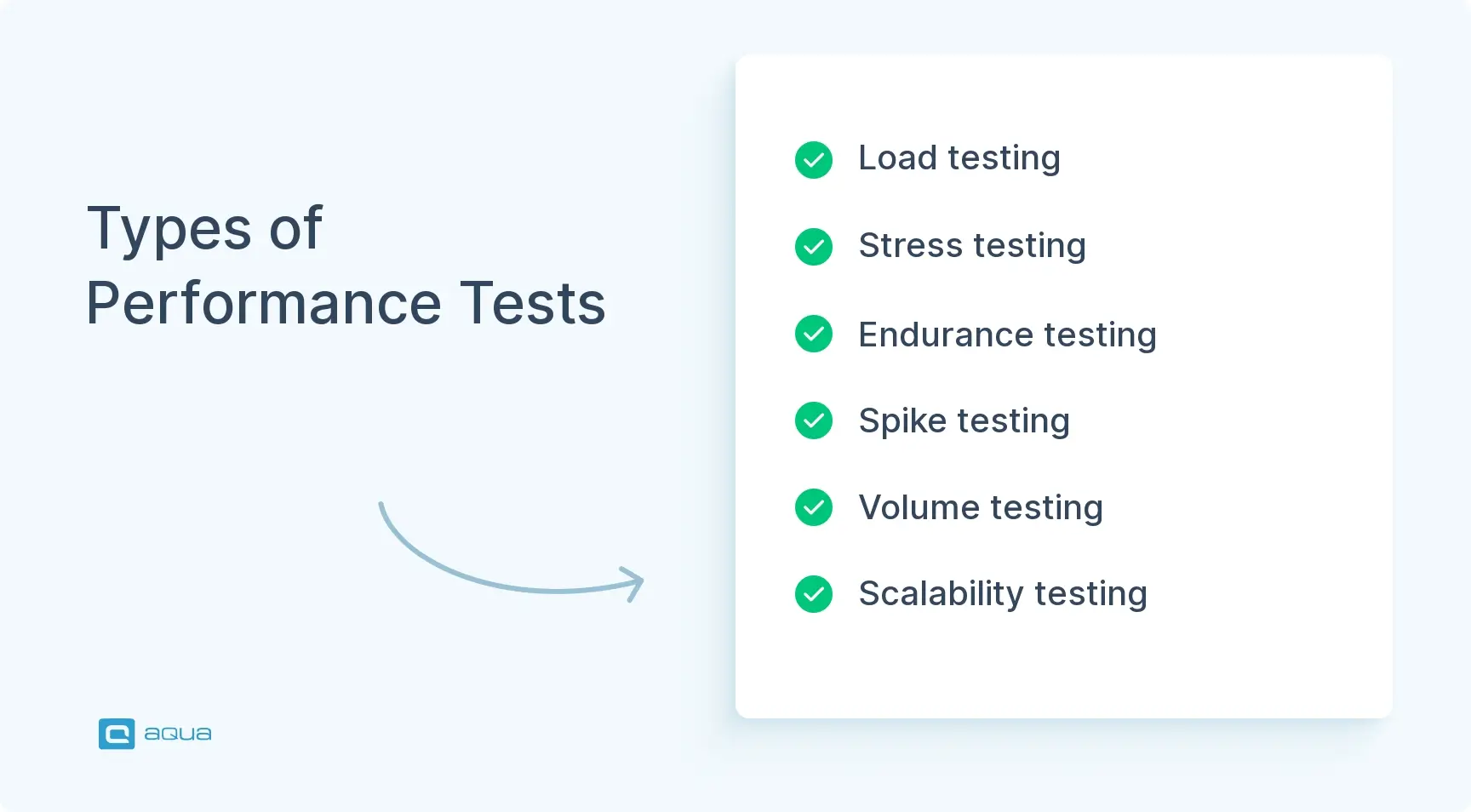In performance testing, you’re essentially stress-testing your app to see where it breaks before your users do it for you. Start by monitoring response times during peak traffic scenarios. Most apps that crash during Black Friday sales never bothered testing beyond normal loads.
Track these four metrics religiously: how fast pages load, how many requests you can handle, what resources get maxed out first, and error spikes. The goal is catching problems when you can still fix them instead of explaining downtime to angry customers.
Your users won’t tolerate slow apps, and neither should you.
- Load testing is an effective way to evaluate how a web or mobile app will behave in real-life situations. It simulates the kind of load that can be put on the system while it is being used by users.
- Stress testing is similar to load analysis, but it focuses more on how well your system will perform under high loads, which may not be normal.
- Endurance testing refers to how long your software can handle extreme amounts of traffic and how fast it recovers from any issues that arise during this time.
- Spike testing focuses on how quickly your web page responds once a spike occurs. For example, if you are hosting multiple content all on one page, spike testing will help you determine whether or not this content will stay up during spikes in traffic.
- Volume testing refers to how many users are accessing your website at once and what happens when they try to access it going over load capacity and/or bandwidth limitations.
- Scalability testing is focused on the ability of an application or service to handle increased demand without experiencing degradation in performance.

You’ve got tons of performance testing options at your fingertips. Browser tools let you poke around actual UI flows, while API-focused ones dig into backend performance. Network and mobile testing tools round out the mix.
Remember: most top tools now plug straight into your existing CI/CD setup. Start by picking one tool that matches your biggest pain point – whether that’s sluggish page loads or API bottlenecks. The integration capabilities have nearly doubled in recent years, so you’re not stuck managing yet another isolated system.
Before we look at the best tools for performance testing, let’s consider how you make test cases for them. Manual test generation has long been the primary way. The latest AI tech, however, allows you to cover a lot of similar scenarios in no time. We recommend aqua’s AI Copilot, as it leverages GPT to generate tests while knowing the context from your entire test suite.
Use AI to make performance test cases
How to Select the Right Performance Testing Tool in 2025
Choosing the right performance testing tool isn’t rocket science, but it does require knowing what you’re actually looking for. Start with your must-haves: which platforms do you need to test, web apps, mobile, APIs, or a mix? Figure out if you need real browser simulation versus lightweight protocols, and whether cloud-based execution fits your budget.
Create a simple checklist with your scripting language preferences, existing CI/CD tools, and any compliance requirements before you even start comparing options. Most teams get caught up in flashy features and forget about boring stuff like licensing costs or how steep the learning curve will be.
Don’t just read reviews. Actually trial 2-3 tools with a small proof of concept using your real application. What works great for e-commerce might fall flat for API-heavy systems. Combining cloud solutions with open-source frameworks will get you the scalability when you need it without being locked into expensive enterprise contracts.
One thing that’s shifted recently; nearly 60% of teams now prioritise tools that can handle both synthetic and real user monitoring. It’s worth checking if your shortlisted tools can grow with you rather than forcing you to switch again in 18 months.
Apache JMeter

One of the best tools for performance testing out there, Apache JMeter was created to analyse load balancers, but it’s now used for testing servers, websites, and applications of all kinds. It is one of the best tools for performance testing because it can simulate multiple users and applications as well as load different types of data such as databases, XML, file systems, email, etc.
JMeter also comes with an Administration Console (JMX). You can use this console to trigger actions, collect and analyse software data, log events, and much more.
When it comes to the management of web and app performance tests and other test types, finding the right tool is critical. Take the aqua test management tool for instance. With aqua’s native integration with JMeter, you can create, track, and record automated test cases on JMeter in real-time. It also lets you add and connect any software to your testing via REST API with a simple setup and automated bulk inputs.
Get 100% performance test coverage
LoadNinja

LoadNinja has an easy-to-use interface with drag-and-drop functionality, real-time monitoring capabilities, graphical data visualisation capabilities, and rich reporting options.
This performance testing tool also has integration capabilities with other tools such as SiteScope and Jira so you can use their reporting data without having these QA management software installed.
You can also use LoadNinja to analyse software performance across multiple environments from development to QA to production. You can even create batch files with LoadNinja which will execute automatically every time you launch it!
PFLB

PFLB is a load testing platform where you can test your web and mobile apps, as well as gRPC and APIs. It is extremely helpful for teams who want to ensure that their product can handle all the action before releasing or scaling up. With PFLB, you will have complete control over your app’s capacity, eliminating the hassle of crashes or those pesky 503 errors. This platform also allows you to save a significant amount of money on cloud computing and compare your software with the competition.
One of PFLB’s standout features is Automatic Test Plan Generation. By linking your Google Analytics account, you can create accurate load profiles that are based on real user data from your website.
Other useful features include support for high geo-distributed loads, custom scripting capabilities, seamless integration with CI/CD processes, and integration with Grafana.
LoadRunner

LoadRunner is a powerful tool for functionality analysis and load generation. The tool can be used to simulate user interactions and load application servers with different types of traffic, such as HTTP or FTP. The results will show you how fast your pages load and how many users are accessing your site. It also gives you an insight into the type of traffic your site is receiving at any given time.
LoadRunner supports many different browsers and operating systems, which makes it easy to use with your own applications. LoadRunner also has a built-in scripting language that allows you to create your own custom scripts.

Get a testing strategy template that enables us to release 2 times faster
LoadView

LoadView is another popular alternative you can use for your website or application. In comparison to LoadRunner, this tool has more advanced features, but it is not as easy to use as LoadRunner. You need to install the Java plugin before using this tool, which may not be an option for everyone.
This program also does not have a built-in scripting language like other tools do, so you will have to write your scripts if you want them in this program.
NeoLoad

NeoLoad is similar to LoadRunner in many ways because both programs are used for analysing web pages and applications in browsers and operating systems from different vendors (such as Internet Explorer, Firefox, Safari, and Opera). However, NeoLoad offers some additional features that make it stand out from the rest.
The main benefit of using NeoLoad over LoadRunner is that it’s one of the few open-source tools for performance testing (which means anyone can look at its code) so you can easily modify it if there is something that doesn’t work how you want it to work. It is also pretty easy to integrate with a bug tracker via REST API. Also, NeoLoad is free for up to five servers so there are no hidden costs or hidden fees involved here either!
RedLine13

RedLine13 is a powerful performance analysis tool for web applications. It uses JavaScript to simulate user interactions with a website. It allows you to evaluate the performance of various features, such as images, videos, animations, scrolling, and loading times. The tool is ideal for helping provide your users with a better browsing experience while they’re on your site.
RedLine13 offers a wide range of features including logging, monitoring, profiling, analysis, recording, and reporting. The tool is based on open standards and supports multiple browsers and devices, making it an ideal solution for any organisation wanting to improve its site’s performance. It can also be used in conjunction with other tools such as Google PageSpeed Insights to help improve the overall site performance.
RadView WebLOAD

RadView’s WebLOAD is a free web-based tool that helps you create load tests for your website and is one of the top performance testing tools for web applications.
WebLOAD is designed to be used by anyone who needs to evaluate their website’s performance during peak hours or in specific scenarios like holiday shopping or Black Friday sales. The tool will also show you how many requests are made per second by all web browsers on your website.
You can set up simple analyses that simulate real-world scenarios or more complex ones that simulate complex interactions with customers such as product customization and checkout forms.
Gatling

Gatling is often regarded as one of the best load testing tools in the industry, particularly for its performance and scalability testing capabilities. Gatling’s user-friendly Domain-specific language (DSL) and robust scripting features enable testers to create complex load scenarios efficiently.
It’s especially well-suited for testing modern applications and APIs. Gatling’s cloud load testing capabilities allow you to simulate heavy loads and stress your applications using distributed test execution. While it’s not entirely free, the open-source nature of Gatling provides a powerful free performance testing tool for many organisations.
BlazeMeter

BlazeMeter stands out as a versatile cloud load-testing platform among the best load-testing tools available. It offers a seamless way to conduct performance testing on your applications and APIs in a distributed and scalable manner. By harnessing the power of the cloud, BlazeMeter allows you to simulate heavy loads from various geographic locations, giving you a realistic view of your application’s performance under different conditions.
Offering both free and paid plans, BlazeMeter’s cloud load testing capabilities make it an attractive option for organisations seeking to optimise their applications’ performance and stability. Its user-friendly interface and comprehensive reporting features enhance its appeal as a top-notch load-testing tool.
Locust

As a free performance testing tool, Locust has gained popularity for its simplicity and effectiveness in load testing. Its scripting approach using Python allows you to define complex load scenarios with ease.
Locust’s cloud load testing capabilities are achievable through its distributed execution feature, enabling you to distribute the load across multiple machines to simulate large-scale user traffic.
One of Locust’s standout features is its real-time web-based user interface, which provides continuous insights into ongoing test progress and detailed results. This real-time monitoring capability allows testers to make informed decisions and promptly address any bottlenecks or anomalies that may arise during testing. As a free and open-source tool, Locust combines user-friendliness with robust capabilities, making it an appealing choice for beginners and experienced testers seeking a potent yet accessible solution for load testing. Its ability to seamlessly integrate simplicity, distributed execution, and insightful real-time reporting solidifies Locust’s position as a compelling option among performance testing tools.
Artillery

Artillery stands out as a versatile performance and functional testing tool. With its YAML or JSON scripting, testers can define a wide range of load scenarios for APIs, microservices, and web applications. Artillery supports cloud load testing by allowing distributed execution and offers integrations with various third-party systems for enhanced insights. As a free performance testing tool, Artillery’s open-source nature and flexibility make it an appealing choice for organisations seeking reliable load testing capabilities.
As a free and open-source performance testing tool, Artillery provides a cost-effective solution if you are seeking dependable load testing capabilities without compromising on quality. Its adaptability, cloud load testing capabilities, and integrative features make Artillery an appealing choice for newcomers and experienced testers looking to ensure the performance and stability of their applications.
K6

K6 is a modern open-source load-testing tool that uses JavaScript for scripting, making it accessible to developers and testers. Its cloud load testing capabilities enable distributed execution of tests, ensuring accurate simulation of real-world scenarios.
K6 emphasises scalability and performance, making it ideal for dynamic and rapidly evolving applications. Its user-friendly scripting interface, real-time metrics, and integrations with external tools further solidify its position among the best load-testing tools available.
Best Practices for Effective Performance & Load Testing
No matter which tool you pick, getting solid results from performance testing boils down to smart practices. Start by setting clear non-functional requirements; max response times under realistic loads, for example. Simulate actual user behaviour instead of robotic patterns. Throw in varied input data, add realistic think time between actions, and test both your Tuesday afternoon traffic and Black Friday chaos.
Gradually ramp up the load rather than slamming your system with peak users right away. This catches bottlenecks before they snowball. Track both application metrics and infrastructure health in real time; CPU spikes often tell a different story than response times alone.
One concrete step that pays off: integrate performance tests into your CI/CD pipeline. Your analysis matters just as much as the test itself. Benchmark first, investigate weird patterns. Optimise the obvious stuff, then re-test. Rinse and repeat until you consistently hit your targets; that’s when you know your system can handle whatever users throw at it.
Conclusion
The stakes are high for software companies today. Customers demand faster speeds and more reliable responses from the services they depend on – and companies are quickly realising that having a strong testing infrastructure executed.
The list of monitoring tools for performance testing above should give you a good start in your performance testing efforts, no matter your environment or the type of system you’re trying to stress test.
Organise your performance testing

















